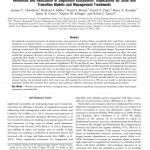Resilience and resistance of sagebrush ecosystems: Implications for state and transition models and management treatments

View article.
In sagebrush ecosystems invasion of annual exotics and expansion of pinyon and juniper are altering fire regimes and resulting in large-scale ecosystem transformations. Management treatments aim to increase resilience to disturbance and enhance resistance to invasive species by reducing woody fuels and increasing native perennial herbaceous species. This study used Sagebrush Steppe Treatment Evaluation Project data to test predictions on effects of fire vs. mechanical treatments on resilience and resistance for three site types. Warm (mesic) WY Shrub and WY PJ sites had lower resistance to annual exotics than cool (frigid to cool frigid) Mtn PJ sites. In WY shrub, fire and sagebrush mowing had similar effects on shrub cover and, thus, on perennial native herbaceous and exotic cover. In WY PJ and Mtn PJ, effects were greater for fire than cut-and-leave treatments and with high tree cover in general because most woody vegetation was removed increasing resources for other functional groups. In WY shrub, about 20% pretreatment perennial native herb cover was necessary to prevent increases in exotics after treatment. Cooler and moister WY PJ and especially Mtn PJ were more resistant to annual exotics, but perennial native herb cover was still required for site recovery. We use our results to develop state and transition models that illustrate how resilience and resistance influence vegetation dynamics and management options.

